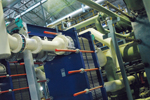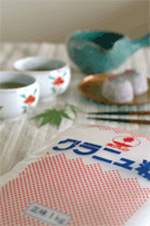The Sweet Source in Japan’s North Country
Don’t think tropics when you consider sugar: in Japan most of it comes from beets grown in a beautiful, often snowy land far removed from traditional images of the land of the rising sun.
DATE 2023-11-28 AUTHOR William RossThe name of the nearest airport hints that things will be different here: Memanbetsu – an Ainu name, from the indigenous people of Hokkaido, Japan’s northern islands. Volcanic mountains and crater lakes appear as the plane descends through the clouds; on the ground, the one-hour drive to the east seems more like a journey through the northern plains of the US and Canada or parts of Scandinavia than the land of temples, sushi and cherry blossoms. The farms here are not the rice paddies and bamboo forests of the rest of Japan, but vast, freshly- ploughed fields broken by the bare trees of woodland forests.
A line of snowy-white mountains rising to the east form the base of the rugged and wild Shiretoko Peninsula. In mid-winter, drift ice covers the Sea of Okhotsk; it is a land of bears and seals, of whales and salmon and the rare, majestic Stellar sea eagle. Hokkaido definitely is a different Japan.
It is also an important part of Japanese agriculture. This area on the eastern tip of Hokkaido grows typical cold-weather crops – potatoes, wheat, animal feed grains and tensai – sugar beets. "It’s really cold here in February," says Katashi Nozaki. "In February, when the ice floes come in, it gets to below -20°C, with high winds and a lot of snow. But our location also means that we get very little fog, which makes it ideal for raising sugar beets." Sugar beets are in fact the largest single crop planted in this area; more than a quarter of all farms cultivate the white, lumpy vegetables that resemble an overgrown turnip. Mr. Nozaki knows a lot about sugar beets because he is the manager of Hokuren’s Nakashari Sugar Beet Factory.
A completely natural product
Officially known as the Hokuren Federation of Agricultural Cooperatives, Hokuren gathers, processes and ships Hokkaido-sourced agricultural, meat and dairy products to the main island of Honshu, provides farmers with seeds and seedlings and conducts agricultural and research and development. Hokuren even has two ships running on a regular schedule between Kushiro in Hokkaido and Hitachi, north of Tokyo, carrying milk and other products. And it operates two sugar factories, the Shimizu Factory to the west in Tokachi, and the Nakashari Factory, the second largest of a total of eight sugar refineries in Hokkaido operated by three different organizations.
Thoughts of sugar often conjure up images of warmer climates and tall fields of sugar cane but, in fact, only 20 per cent of Japanese-produced sugar is sourced from cane. All the rest comes from beets, which need a cool climate. This is why, in 1958, Hokuren built this massive factory in the proverbial middle of nowhere, and why it worked with local farmers to increase the production of sugar beets.
After welcoming us to the factory, Nozaki-san shows a quick introductory video on the process of converting the vegetables into fine crystallized sugar. “We have a seed factory in Memanbetsu, but we’re also working in new ways to provide seedlings so farmers have a longer growing season. Seedlings in cardboard tubes are then mechanically inserted into the ground from a tractor. That makes planting a lot easier, and the tubes simply break down as the plant grows,” he says. Extending the season as long as possible is no small concern when snow is on the ground from November to May.
40 processing steps
After harvesting in the autumn, the sugar beets are trucked to the factory and set out in huge piles (another place where Hokkaido’s cold climate comes in handy, keeping the beets cool until they can be processed). "Sugar making is pretty involved," Mr. Nozaki says, then smiles. "But it’s a simple process as well. We’re not adding anything artificial throughout the process, and we’re simply using machinery to get a natural product." He illustrates this with a flowchart outlining the some 40 different steps in the process, before we head out into the plant.
The beets are first washed, then mechanically sliced into small strips called cossettes. "We can’t actually see anything right now, because all the slicing is done during the fall and winter," Mr. Nozaki explains, holding a serrated section of the cutters as a worker fiddles with the partially disassembled slicer. "You’d see the sliced beets come out of the slicer and go up into a diffuser. Beets are mixed with hot water during 60 to 90 minutes to extract the sugar." Beets naturally contain about 18 per cent sugar, he explains, meaning that they actually have a higher sugar content than sugar cane.
With the sugar extracted from the beets, the remaining material, called pulp, is removed, pressed and sold as animal feed. The juice is then treated with a mixture of lime and carbon dioxide, which removes non-sugar materials. The remaining juice can be stored for later processing, which reduces the pressure on the plant to process all of one season’s beets at once – and why we get to actually see the rest of the process.
 The juice is filtered before passing through two more processes in which calcium and excess colour are removed. It then enters one of several Alfa Laval AlfaVap evaporators in the plant, where it is boiled and reduced to "thick juice," a heavy, syrupy material. It is about to become crystallized sugar.
The juice is filtered before passing through two more processes in which calcium and excess colour are removed. It then enters one of several Alfa Laval AlfaVap evaporators in the plant, where it is boiled and reduced to "thick juice," a heavy, syrupy material. It is about to become crystallized sugar.
Climbing a staircase – and into a much warmer environment – Mr. Nozaki announces that we are literally about to step into a different phase of production. "Cross over this line, and we start the crystallization process," he says. Mr. Nozaki leads the way to a tall stainless steel tank with a series of portholes up the face. Inside is the slightly opaque juice, splashing up against the lower window.
"To make a good sugar crystal, the difficult part is in controlling temperature and pressure," he explains. Boiling at a reduced pressure, the liquid sugar will be infused with fine sugar seed that will provide a base for the crystals to begin forming. The neighbouring tank, by comparison, is much more opaque, with clearly visible sugar crystals – and the level is several metres higher. "It’s the same amount of juice," Mr. Nozaki explains. "As the crystals form, the volume inside continues to increase."
Tight cost control
One question remains – where are all the people in this huge building? Partly, Mr. Nozaki explains, it’s because this is not the peak season, when 67 part-time employees join the 95 full-time workers in the factory.
Opening another door, and the reason becomes clearer: most people actually control the processes at computer screens. "Even as the factory has grown greatly over the years, the number of employees has decreased," he says. Japanese-made sugar simply couldn’t compete with imports on price, and even with government subsidies, Hokuren needs to keep a tight rein on costs.
That need, Mr. Nozaki says, was also a major reason for a complete renovation of the factory’s equipment in 2005, including four new AlfaVaps, and an AlfaCond condenser to help recover energy from the steam that is the lifeblood of a sugar factory. "Installing more Alfa Laval equipment was an important part of our plans for cutting energy costs," he says. "They are far more efficient than the equipment we previously had in the factory, and maintenance is much easier." While he can’t give a precise figure, Mr. Nozaki says that, "we’ve accomplished the energy savings we hoped for."
Nozaki-san then leads the way down several flights of stairs to centrifuges, where the crystallized sugar is spun and dried – into the massive silo outside. Later it will be packaged into everything from family-size plastic bags to sling-hoisted one-tonne bags of the sweet stuff, and sent to consumers and manufacturers across the country.
Pioneering solutions
Hokuren had Alfa Laval equipment in its factories dating back to the 1970s.
They first introduced an AlfaVap for evaporation in the Nakashari factory in 1992 and they now operate a total of 39 AlfaVaps in its Hokkaido factories. This builds on the more than 90 other Alfa Laval plate heat exchangers the two factories were already operating.
The first AlfaVap was used as a first-effect booster – each ‘effect’ being a stage in the processing of the juice. Hokuren saw the high heat transfer performance of the AlfaVap and appreciated the fact that it was extremely compact and easy to install.
Because increasing the number of effects reduces the amount of steam, and therefore energy required, Hokuren decided to install a five-effect complete station with the AlfaVap rising film type plate evaporator in its Shimizu Factory in 1995. "The only problem was that we had never done an installation like that before," says Akihiro Kumagai of Alfa Laval in Japan. Through close teamwork between Hokuren and Alfa Laval in both Japan and Sweden, they developed a solution that met the customer’s needs. "The system worked very well, and our relationship grew much stronger," he says.
So strong, in fact, that when the Shimizu Factory was renovated in 1998, Hokuren ordered 17 AlfaVaps. "They also wanted to set up an eight-effect complete station for raffinnate processing – a liquid remaining after removing sugar from molasses", Mr. Kumagai says. "This was something else that we had never done, but we were very confident after the success in 1996. Every-thing worked perfectly."

